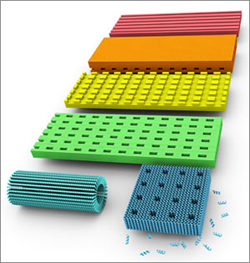A group of researchers from the Wyss Institute for Biologically Inspired Engineering at Harvard have designed large DNA crystals with an accurately defined depth and sophisticated features, paving the way for new and advanced nanodevices.
 Researchers have achieved 32 different–shaped crystal structures using the DNA–brick self–assembly method. (Credit: Harvard's Wyss Institute)
Researchers have achieved 32 different–shaped crystal structures using the DNA–brick self–assembly method. (Credit: Harvard's Wyss Institute)
The team of researchers created 32 DNA crystals with an array of complex three-dimensional features using their ‘DNA-brick self-assembly’ technique, which enabled them to overcome the challenges involved in the crystallization of complex three-dimensional DNA nanostructures.
The research group have previously designed over 100 virus-sized three-dimensional intricate nanostructures using this technique, with the newly created periodic crystal structures being a thousand times larger in size when compared to the particles they have previously built.
The DNA brick technique uses short, synthetic DNA strands, to build sophisticated nanostructures which function as interlocking Lego® bricks. A computer simulation of a molecular cube is used in order to design the nanostructure, from which each brick is included or stripped independently to in order to obtain the overall desired shape.
Based on the design, the DNA strands are added together and self-assemble themselves to obtain the designed crystal structures. The unique design strategy of the DNA brick technique is its modularity. The innovative technique can create virtually any design with ease, thanks to its ability to include or remove components from a three-dimensional master canvas.
What have been mere visions of how the DNA molecule could be used to advance everything from the semiconductor industry to biophysics are fast becoming realities.
Don Ingber, M.D., Ph.D, Wyss Institute Founding Director.
The team of researchers demonstrated the ability to place gold nanoparticles into defined two-dimensional architectures, which have a separation of less than two nanometres along the crystal structure. This feature will be critical in order to enable the scalable production of the quantum devices of the future. This research has been reported in Nature Chemistry.